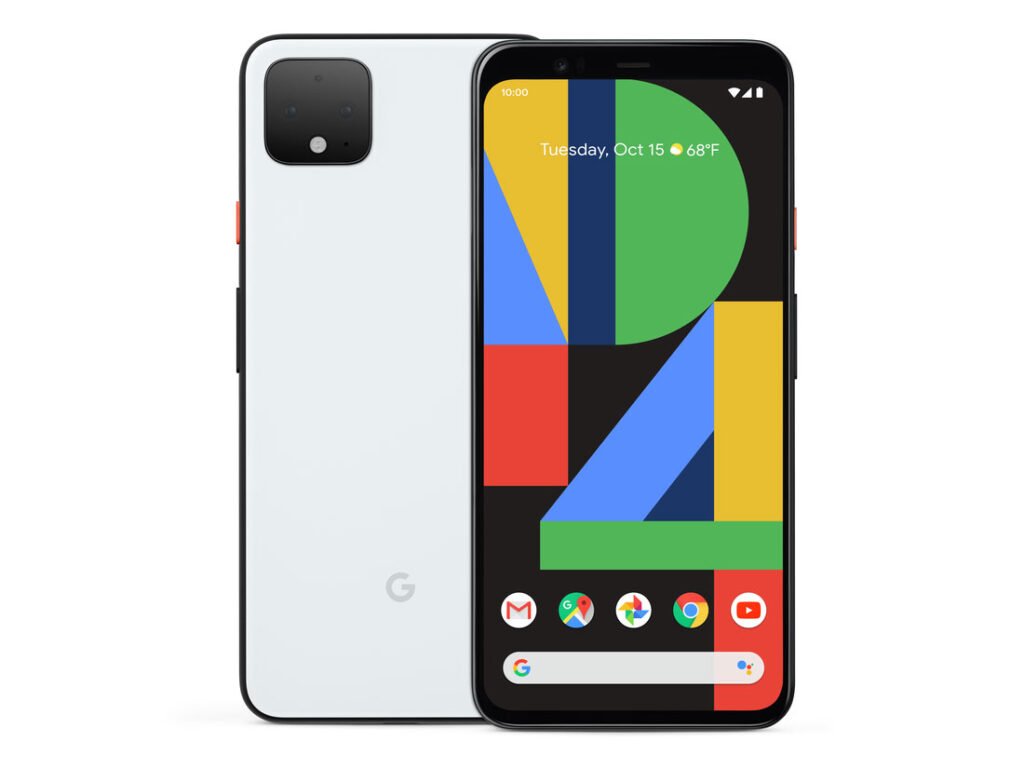Stepping into the spotlight in October 2019, the Google Pixel 4 and Pixel 4 XL marked a significant departure from previous designs and introduced cutting-edge technology like radar-based gesture control and high-refresh-rate displays. While pushing boundaries, this generation also made some bold choices that drew considerable debate.
Design: A New Look, Goodbye Fingerprint Sensor

The Pixel 4 series underwent a noticeable redesign:
- Square Camera Bump: Gone was the signature glass window; instead, the rear cameras were housed in a prominent square module in the top corner – a design trend becoming popular at the time.
- Materials & Finish: The phones featured a matte-finished aluminum frame and a glass back (Gorilla Glass 5) available in glossy or matte finishes, depending on the color. The two-tone look was retired.
- The “Forehead”: Instead of a notch like the Pixel 3 XL, both the 4 and 4 XL featured a significant top bezel or “forehead.” This wasn’t just for symmetry; it housed a sophisticated array of sensors for the new Face Unlock system and the Soli radar chip.
- Fingerprint Sensor Removed: In a major shift, Google ditched the rear fingerprint sensor entirely, relying solely on the new Face Unlock for biometric security.
- Colors: The lineup came in Just Black, Clearly White, and a popular limited-edition “Oh So Orange.”
- Continued Features: IP68 water resistance and front-facing stereo speakers carried over, but the headphone jack remained absent.
Hardware: Smooth Displays, Soli Radar, and a Step Up (and Back?)
The Pixel 4 brought significant hardware changes, both innovative and questionable:
- Processor & RAM: Powered by the Qualcomm Snapdragon 855, and crucially, RAM was upgraded to 6GB, addressing a key criticism of the Pixel 3. Storage options remained 64GB and 128GB.
- 90Hz Smooth Display: Both models featured beautiful OLED displays with a faster 90Hz refresh rate (“Smooth Display”), making scrolling and animations feel noticeably smoother. However, controversy arose as it was discovered the display would often drop back to 60Hz below certain brightness levels (Google later issued updates to enable 90Hz more often) and was disabled in specific popular apps like Google Maps.
- Project Soli & Motion Sense: The Pixel 4 debuted Google’s miniature Soli radar chip. This enabled “Motion Sense” features:
- Presence Detection: The radar could detect when you were near or reaching for the phone, priming Face Unlock for faster recognition or keeping the screen on while you were looking at it.
- Quick Gestures: Allowed users to wave their hand over the phone to skip music tracks, snooze alarms, or silence calls without touching the screen. Real-world utility and reliability were often questioned, and the feature wasn’t available in all regions.
- Face Unlock: Replacing the fingerprint sensor, the new Face Unlock system used the Soli radar, IR cameras, dot projector, and flood illuminator housed in the top bezel. It was generally very fast and secure but initially drew criticism for working even if the user’s eyes were closed (a fix was later released).
- Battery Concerns: While the Pixel 4 XL had a respectable 3700mAh battery, the smaller Pixel 4 featured a 2800mAh battery – smaller than its predecessor, the Pixel 3. This resulted in widely criticized poor battery life for the standard Pixel 4 model. Wireless charging continued to be supported.
- Titan M Security: The Titan M security chip returned for enhanced hardware security.
Cameras: Telephoto Arrives, Ultrawide Departs
For the first time on a main Pixel, Google included dual rear cameras:
- Main + Telephoto: A 12.2MP main sensor (f/1.7, OIS+EIS) was paired with a 16MP telephoto lens (f/2.4, OIS+EIS, ~2x optical zoom). This significantly improved zoom quality, aided further by Super Res Zoom software.
- No Ultrawide: In a decision that baffled many reviewers, Google omitted an ultrawide camera, a feature becoming standard on competing flagships.
- Front Camera: A single 8MP wide-angle front camera was used.
- Software Brilliance Continues:
- Live HDR+: Users could now see the HDR+ effect in the viewfinder before taking the shot.
- Dual Exposure Controls: Offered separate sliders to adjust brightness and shadow detail independently for more creative control.
- Astrophotography: An impressive extension of Night Sight allowed for long exposures (up to several minutes when on a tripod) to capture stars and even the Milky Way.
- Improved Portrait Mode and Super Res Zoom capabilities.
- Storage Perk Change: The era of free unlimited original-quality Google Photos backup ended with this generation.
Software: A Faster Assistant and Transcription Smarts
Launching with Android 10, the Pixel 4 showcased software refinements:
- New Google Assistant: Thanks to more on-device processing, the Assistant was faster, could handle consecutive commands (“continued conversation”), and had a more compact interface that didn’t take over the whole screen.
- Recorder App: A new built-in app offered impressive real-time transcription and audio search capabilities, all processed locally on the device.
- Motion Sense Integration: Gestures were tied into system functions like silencing alarms/calls and media playback control.
The Pixel 4 series received OS updates up to Android 13, with security updates ending in late 2022 / early 2023.
Reception and Legacy
The Pixel 4 generation received a distinctly mixed reception. The smooth 90Hz display, excellent camera performance (especially zoom, low light, and astro), fast Face Unlock, and the new Assistant and Recorder app earned praise.
However, it faced significant criticism for the standard Pixel 4’s inadequate battery life, the controversial lack of an ultrawide camera, the often-gimmicky feel and limited utility of Motion Sense gestures, and the removal of the reliable fingerprint sensor.
The Pixel 4 is remembered as a generation where Google took risks with innovative hardware like the Soli radar, but perhaps didn’t quite nail the execution or balance it with core user needs like battery endurance and versatile camera options.
